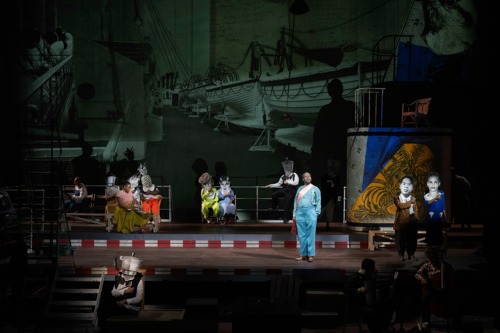
William Kentridge's The Great Yes, The Great No takes a stand for freedom on the high seas.
by Jake Cline
Two years ago, William Kentridge brought a provocative, multimedia stage show about the role of Africans in World War I to the Adrienne Arsht Center. The Head & the Load arrived like an act of profound resistance—against war, colonialism, racism and the shelving of undertaught histories. Kentridge, of South Africa, also pushed back hard against conventional storytelling, offering a collage of operatic acting, discomforting music, baroque visuals and martial choreography. That such a challenging, exhilarating work occurred during Miami Art Week, a celebration of naked capitalism and lowbrow extravagance, only contributed to the show’s destabilizing effect.
Now, Kentridge is returning to the Arsht—and Miami Art Week—with another work rooted in historical fact and loaded with relevance. The Great Yes, The Great No is based on a real-life voyage by sea from Marseilles, France, to the Caribbean island Martinique. In March 1941, some of the 20th century’s most influential artists and thinkers boarded the Capitaine Paul-Lemerle, a retrofitted cargo ship, to escape the Nazis and the collaborationist government in Vichy France. Father of surrealism André Breton, Cuban painter Wifredo Lam, German artist Max Ernst, Russian writer Victor Serge and French anthropologist Claude Lévi-Strauss were among the notable refugees.

(Photo of William Kentridge by Stella Olivier.)
Kentridge’s show imagines an even wilder passenger manifest, with then long-dead figures such as Josephine Bonaparte sailing with Mexican artists Frida Kahlo and Diego Rivera, French entertainer Josephine Baker, Martinique philosopher Frantz Fanon, Martinique writer Suzanne Césaire, Soviet dictator Joseph Stalin and anti-Stalinist revolutionary Leon Trotsky, among others. Leaning into his avant-garde tendencies, Kentridge has put Charon, the underworld ferryman of Greek mythology, at the Capitaine Paul-Lemerle's helm.
With Western nations once again lurching toward—when not outright embracing—authoritarianism, bigotry and xenophobia, The Great Yes, The Great No looks to history in an attempt to make sense of the present and to prepare for the future. “There’s echoes of migrants trying to flee one country to a place of safety today,” Kentridge said of the show, which he is directing with Nhlanhla Mahlangu and Phala O. Phala, during a 2023 lecture in Johannesburg. “It also has echoes of earlier journeys across the Atlantic of slaves that were brought from Africa to the Caribbean.”
Kentridge is not the only artist in recent years to consider the horrors of Vichy France. The period that followed Germany’s invasion of France during World War II, France’s signing an armistice with Germany in June 1940 and the formation of a collaborationist “French State” has been addressed in recent novels such as Cécile Desprairies’ The Propagandist, television series such as Transatlantic and movies such as Lee, about the war photographer Lee Miller. Transatlantic in particular concerns the artists (Max Ernst, André Breton, et al.) and voyage featured in The Great Yes, The Great No.
Meanwhile, historian Robert O. Paxton’s landmark 1972 book Vichy France: Old Guard and New Order, 1940-1944 has garnered fresh interest as liberal democracies cede ground, figuratively and literally, to far-right movements. Kentridge’s timing with The Great Yes, The Great No is alarmingly pertinent.

(Photo of The Great Yes, The Great No by Monika Rittershaus.)
Born in 1955 in Johannesburg, where he still lives, Kentridge has worked throughout his career in a variety of media, especially film, drawing, painting, sculpture and theater. His pieces can be found in the permanent collections of the Tate galleries, the Museum of Modern Art, the Art Institute of Chicago and other prestigious institutions.
Kentridge’s art can be playful or sobering, representational or abstract, clear or opaque. His artistic philosophy appears equally open and unfixed. He seems happily restless, as demonstrated in Self-Portrait As a Coffee Pot, the nine-part documentary series he released this year on the streaming platform Mubi. Filmed in his Johannesburg studio during the COVID-19 pandemic, the series presents, through cinematic sleight of hand, Kentridge interrogating himself (and sometimes multiple versions of himself) about life, art, history and the meaning of it all.
“How do we turn hope into action?” Kentridge asks his primary doppelgänger in the series. “How to change the world? How to make it a different place?”
He lands on a possible answer while working out a new piece based on a Dmitri Shostakovich symphony, whose techniques he repurposes in The Great Yes, The Great No. “We hope to find a way of constructing a cardboard history,” he says, “a collage of different impulses of the skills, taking all the fragments, the whims, the energy of everybody in the studio and seeing if we can bring together some sense of history as a construction, as something that we make and understand, rather than just discover.”
The Great Yes, The Great No premiered in July at the LUMA Arles in Arles, France and was performed later that month at the ImPulsTanz Festival in Vienna. The show makes its North American premiere December 5-7 in the Knight Concert Hall.
(Top: Photo of The Great Yes, The Great No by Monika Rittershaus.)




